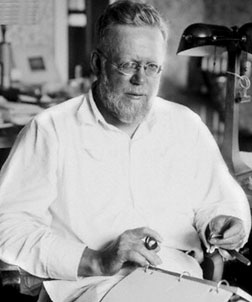Genesis for Apple Inc. iPhone Was Pitt Experiments That Led to First Wireless Phone "Call" in 1900
 Reginald A. Fessenden
Reginald A. FessendenThe iPhone 4 hitting stores June 24 may put Cupertino, Calif.,-based Apple Inc. ahead in wireless technology, but behind it is the work of a University of Pittsburgh engineering professor 110 years ago that establishes Pittsburgh as a key location in the advent of wireless telephones.
Reginald A. Fessenden, chair of Pitt’s electrical engineering department from 1893 to 1900, began experimenting with wireless telephones in 1898, had a wireless communication system functioning between Pittsburgh and Allegheny City (now the city’s North Side) in 1899, and achieved the first wireless voice transmission in December 1900, shortly after he left the University. That first transmission, Fessenden recalled in 1926, was “poor in quality, but quite distinct and entirely intelligible.” In 1907, Fessenden established successful wireless telephone connections that spanned up to 400 miles.
“The modern cell phone is essentially what Fessenden wanted: A telephone where people could talk normally to each other and not be tethered by cords,” said Marlin Mickle, the Nickolas A. DeCecco professor of electrical and computer engineering in Pitt’s Swanson School of Engineering. Mickle is familiar with Fessenden’s work and also develops wireless technology, particularly devices powered by radio frequency.
Fessenden’s work in wireless communication was distinct from that of such famous contemporaries as Guglielmo Marconi, Mickle said. Fessenden in fact considered the Italian inventor’s technology unreliable and described his own as “an entirely new method” of wireless communication. Marconi’s wireless telegraph operated via electric pulses and required operators who knew Morse code; Fessenden, on the other hand, focused on analog communication that would transmit a person’s actual voice through continuous electromagnetic waves.
In 1902, Fessenden received a patent for what could be called the original “app”—his Apparatus for Signaling by Electromagnetic Waves, the basic technology behind wireless telephony. (In 1915, Fessenden wrote in The New York Times that the public was denied wireless telephony for 10 years after the patent “fell into the hands of a couple of Pittsburghers who secured these patents without paying a cent for them.”)
On Dec. 21, 1906, Fessenden publicly demonstrated his wireless telephone with a “transmission of speech” over the 10 miles between Brant Rock and Plymouth, Mass., according to an eye-witness account by the editor of the American Telephone Journal. However, Fessenden overshadowed his own success in wireless telephony three days later by making, according to his records, the first radio broadcast of voice and music—which included himself playing the violin and reading from the Bible—for which he is better known today.
In fact, Fessenden is most often recognized for his contributions to radio—he also achieved the first two-way trans-Atlantic communication in January 1906 between Brant Rock and his station in Scotland. But his broadcasts were largely unacknowledged at the time and Fessenden himself was dedicated to perfecting the wireless telephone, Mickle said. Within a year of his Dec. 21 transmission, Fessenden had wireless connections from Brant Rock to Brooklyn, N.Y., and Washington, D.C., distances of 190 and 400 miles, respectively. Fessenden later said that the quality of the Brooklyn-Brant Rock transmission exceeded that of standard telephone lines.
In 1926, nearly 30 years after his first wireless experiments at Pitt, Fessenden reflected on the trying process in a speech to the Radio Institute in New York City by saying, “A good deal of hard work went to the inventing of the wireless telephone: both research, going over a fishing place to find what fish are there, and invention, or deciding you want a certain fish and going after it until you get it.”
Other Stories From This Issue
On the Freedom Road

Follow a group of Pitt students on the Returning to the Roots of Civil Rights bus tour, a nine-day, 2,300-mile journey crisscrossing five states.
Day 1: The Awakening
Day 2: Deep Impressions
Day 3: Music, Montgomery, and More
Day 4: Looking Back, Looking Forward
Day 5: Learning to Remember
Day 6: The Mountaintop
Day 7: Slavery and Beyond
Day 8: Lessons to Bring Home
Day 9: Final Lessons

